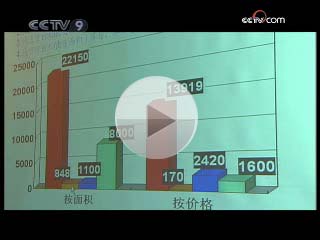Source: CCTV.com
09-22-2008 15:50
 |
This man has been the centre of a lot of attention in recent years. This is a co-operative housing contract. His name is Yu Linggang. He introduced co-operative housing in China.
In 1998, the Chinese government abolished the welfare-oriented distribution
 |
of public housing. So people in the cities began purchasing commercial residential property. The average cost of commercial property nationally was under 2,000 yuan a square metre at the time. But housing prices have soared in recent years across China. The average housing price in Beijing has risen
from 7,000 yuan per square metre in 2005 to the current 13,000 yuan. It was against this background that a co-operative appeared.
Three years ago, on December the 1st, 2003, someone using the online name “Lancheng Muyu” posted a proposal in a dozen online forums. He suggested eliminating real estate developers by gathering together potential house buyers to jointly construct an apartment building. That post marked the launch of co-operative housing. Lancheng Muyu’s real name is Yu Linggang.
By profession, Yu Linggang is a mainframe computer maintenance engineer. His idea of co-operative housing stemmed from his frustration with the real estate market.
The various problems in the real estate market in 2003, meant that the situation was ripe for co-operative housing to flourish. That year, the price of commercial residential property in Beijing was over 4,400 yuan per square meter. Through co-operative housing development, the cost would be reduced to the minimum. Many people were attracted by Yu Linggang’s proposal, and within an hour that morning, he had received several short messages.
Together with the interested people, Yu Linggang refined his plan. In August 2004, the government introduced a policy, changing the agreement-based transfer of state-owned land, to a system of public bidding, auction and listing.
The change sent shockwaves through the real estate market. Housing prices reached a new historic high. Yu Linggang’s unique proposal attracted widespread media attention.
The first thing was to gather enough people. On December the 18th, 2004, Yu Linggang and his supporters made their first official decision; it was to invite people to join their co-operative housing scheme. He planned to gather 200 to 300 participants and co-construct a building through democratic negotiations. He reckoned that co-operative housing could reduce costs by at least 20%, while the participants could also make money from the auxiliary facilities. The news became a focus of intense media interest.
Although there are obvious advantages to co-operative housing, with several hundred people together, there are also risks. These involve such areas as capital management, time costs, and organizational management.
Despite the risks, enthusiasm remained high for co-operative housing.
A month after the news was published, more than 500 people had signed up for Yu Linggang’s scheme.
A public meeting held two months after the news was published, marked the official start of the co-operative housing scheme.
More than 600 people signed up.
They all filled in a form and paid 100 yuan to become official members of the alliance.
Yu Linggang had never imagined that so many people would join him.
The participants in the meeting were divided into 20 groups, according to where they lived.
Each group was assigned a leader in charge of organization and communication.
